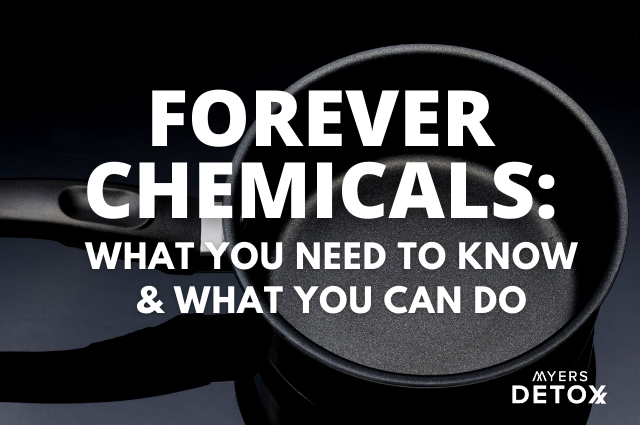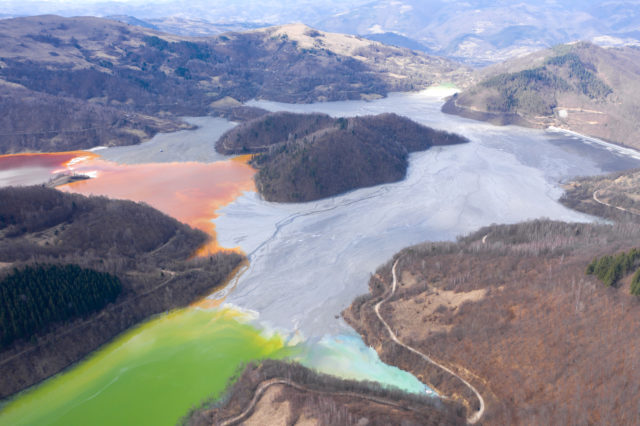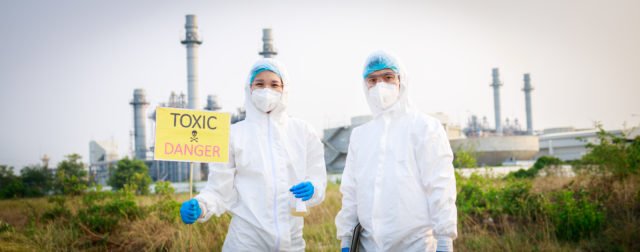Forever Chemicals: What You Need to Know & What You Can Do

Back in the 1930s, scientists were thrilled to discover a type of chemical that would make it possible to cook in a pan without having to spend hours soaking and scrubbing. These chemicals went on to find their way into various industries, from clothing to furniture and beyond.
Unfortunately, it wasn’t until many decades later that environmentalists started to sound the alarm; these wonder chemicals come with one significant drawback – they don’t break down. Once these chemicals are leached, they are stuck in the environment forever.
While we’ve been dealing with these “forever chemicals” for many years now, trying to mitigate that damage, a new report from the Environmental Working Group (EWG) recently stated that an estimated 20 million acres of cropland across the United States are contaminated with forever chemicals[1].
Furthermore, the EWG estimates that approximately 30,000 different companies currently leak forever chemicals directly or indirectly into the environment[2].
What are forever chemicals, and what can we do about them? In this article, you’ll learn:
- What these chemicals are made of
- Why they are impossible to break down
- The toll they’re taking on farmland across the country
- The threat they pose to your health
- What you can do to mitigate your exposure to forever chemicals
What Are Forever Chemicals?

Forever chemicals, also known as PFAS (per- and polyfluoroalkyl substances), are man-made chemical substances used widely across various industries. Primarily, PFAS are used to make coatings that are resistant to heat, oil, stains, grease, and water.
Due to their unique ability to provide resistance, they’ve found their way into our kitchen appliances, clothing, food packaging, personal care items, furniture, and more. And of course, these are only the direct routes by which PFAS enter our environment. In addition to the products that they’re intentionally added to, PFAS are now contaminating our food and water supply as well.
Some common names by which PFAS may go by include PFOS, PFOA, GenX, Teflon, and C-8, but there are more than 5,000 compounds that fall under this category[3].
What Makes Them Stick Around “Forever”
PFAS consists of a fusion of carbon and fluorine atoms. In nature, the bond between these two atoms is so strong that it can’t be broken down. This means that once they enter the environment, the natural world doesn’t know what to do with them, so they stay intact and continue to contaminate whatever system they’ve entered.
What makes ridding the environment of these persistent chemicals even more challenging is that production plants that use PFAS, at any point in time, will continue to hold these residues for up to 15 years after they cease use. This means that if a factory decides to make a new PFAS-free product after using PFAS, the new products will still become contaminated.
How long do these chemicals actually stick around? It’s currently estimated that it could take several centuries for these chemicals to finally disappear from the environment.
Forever Chemicals and Farmland

In a stunning new report from the EWG, investigators explain that upwards of 20 million acres of cropland across the United States are contaminated with forever chemicals[4]. How exactly did the land where we grow our food and graze our animals become so contaminated?
Farmers often use sewage sludge as a fertilizer for the land. While this offers an economical and somewhat nutrient-rich option, most sewage sludge is contaminated with forever chemicals[1].
Sewage sludge is a product of the wastewater treatment process. Due to industrial processing, large amounts of PFAS are discharged into wastewater treatment plants, where they build up in the sludge. This sludge is then applied to land as fertilizer. While federal rules call for limitations on pathogens and metals in sludge, there are no national requirements to test biosolids for the presence of PFAS or warn farmers they could be using contaminated sludge on their crops[5].
PFAS can become an insidious toxin once they are applied to soil as these chemicals can build up in food crops as well as crops used for animal feed like corn and hay. Once the animals consume these crops, they too become contaminated with PFAS. As a result, our food supply (including edible plants and animal products) is becoming increasingly contaminated with PFAS.
Sadly, several farmers have been forced to euthanize their farm animals due to high levels of PFAS[1].
Other Sources of Forever Chemicals

Due to the wide-ranging uses of PFAS, these chemicals are used in the manufacturing process of many different products across several industries. Furthermore, due to their ability to leach from products and pollute various environments, secondary exposure to PFAS is also quite common.
Of note, along with the contamination of our food supply due to the use of sewage sludge in agriculture, the Environmental Working Group (EWG) estimates that 110 million Americans’ drinking water is contaminated with PFAS[6]. This is due to PFAS leaching into the water supply from manufacturing processes. PFAS are highly mobile in water, and as they remain intact, they can linger in the water supply for many years.
Common sources of PFAS include[7][8]:
- Food packaged in PFOS-containing materials
- Food grown in PFAS contaminated soil or water
- Stain and water-repellent fabrics
- Non-stick (Teflon) products like pots and pans
- Polishes
- Waxes
- Paint
- Cleaning products
- Fire-fighting foams
- Chrome-plating facilities
- Electronics manufacturing facilities
- Drinking water that has been contaminated through landfills, manufacturing plants, or wastewater treatment plants.
- Fish and animals that have accumulated PFAS over time through environmental exposure.
- Hair spray
- Makeup products like eyeliner, foundation, and concealer
- Sunscreen
- Shampoo
- Shaving cream
Health Risks Associated with Forever Chemicals

If forever chemicals can’t break down in the environment, you can only imagine what happens once they get into your body. Put simply; these compounds end up accumulating in your cells and tissues as your body has no way of breaking them down.
In fact, it can take up to 15 years for levels of PFAS to reduce by half in the human body. And unfortunately, research shows that most people in the United States have measurable levels of PFAS in their blood[9].
Some specific health risks that are associated with PFAS include[8][9][10][11]:
- Changes in liver enzymes
- Small decreases in infant birth weights
- Increased risk of high blood pressure or preeclampsia in pregnant women
- Increased cholesterol levels
- Thyroid issues
- Weakened immunity
- Developmental effects in infants
- Infertility risks
- Interference with hormonal systems
- Impaired insulin and blood sugar regulation
How To Mitigate Exposure To Forever Chemicals
 Avoiding PFAS entirely is almost impossible, but there are several things you can do to mitigate your exposure to these harmful compounds.
Avoiding PFAS entirely is almost impossible, but there are several things you can do to mitigate your exposure to these harmful compounds.
Although avoiding PFAS altogether may be near impossible, there are certainly ways that you can mitigate and therefore decrease your exposure to these harmful compounds.
Avoid Non-Stick Cookware
Non-stick cookware may add ease to your cleanup process, but most non-stick brands out there use Teflon, a form of PFAS. Over time, the chemicals on the non-stick surface can leach into your food as you cook.
Stainless steel is an excellent alternative. You can also find chemical-free stone cookware. You may need to soak these pans to get the excess food off for a few minutes after cooking, but that task is a small price to pay when it comes to avoiding the buildup of PFAS in your body.
Opt For Natural Personal Care Products
The personal care industry is one of the most dangerous when it comes to PFAS. These products are not only used daily, but they go directly on your skin. Your skin is your largest organ and one that will easily absorb whatever you put on it — chemical compounds included.
PFAS can be found in everything from eyeliner to foundation to shaving cream and more.
Luckily, there are several brands that formulate to keep dangerous compounds out of their personal care products. If you’re not sure which brand to go with, you can use the Environmental Working Group Skin Deep database. Here you can search by ingredient, product, or brand to find the right products for you.
Avoid Stain-Repellent Treatments
If you have little kids or pets, you may be tempted to get stain-repellent treatments on your furniture and carpets. These treatments not only bring more PFAS into your home, but they could leach into the air you breathe.
Much like the case with non-stick cookware, the convenience of stain-repellent treatments is not worth the risks of PFAS.
Be Wary Of Water-Repellent Clothing
Many outdoor sporting goods and clothing lines use water-repellent coatings. Bathing suits, jackets, boots, etc., may all be sprayed with PFAS to keep the water off. Some people even spray water repellents on all their suede and leather shoes to avoid water stains.
If you see the words “water repellent” on any product you are about to buy, that should be a big red flag that PFAS are present.
Use Water Filters
As the EWG stated, it’s estimated that 110 million Americans are drinking water that is contaminated with PFAS. This means that even if you’re doing your best to avoid obvious sources of PFAS, they could still be sneaking in through your water supply.
No matter where you live, you should always be using a water filter.
The best filters for PFAS are reverse osmosis filters. You can have these filters installed right into your home, or you can use external filters (which are a bit less expensive) and run your water through the filters before you use it.
PFAS will not degrade by boiling water, so please be sure to always filter your water before using it for tea, coffee, or any type of cooking.
Eat At Home
Eating out is another way that PFAS can sneak into your diet. Restaurants tend to use lower-quality cookware that likely contains Teflon or other types of non-stick PFAS. What’s more, the to-go packaging at fast-food restaurants is a known source of PFAS.
Higher-end restaurants are more likely to use stainless steel as opposed to Teflon cookware, but it could become pretty expensive to only eat out at high-end establishments.
Cooking from home is one of the best ways to truly stay on top of your food quality. When you dine out, you rarely know if the food you’re eating is organic, grass-fed, free-range, or fresh.
Not to say that you should never treat yourself to a meal out, but do so mindfully and try to cook most of your food at home whenever possible.
Support Detoxification
Unfortunately, even if you follow all of the above guidelines, you’ll likely still have some level of PFAS in your body. Especially with the new information coming out about how contaminated the agricultural environment is. As research shows, most Americans have a measurable amount of PFAS in their blood[9].
If these chemical compounds are somewhat unavoidable, the only way to truly mitigate the damage is to help your body out by enhancing your ability to detoxify.
Today, our world is littered with toxic insults, pollution, heavy metals, forever chemicals, and the list goes on. Caring for your liver and your detox pathways is really no longer a luxury; it’s become a crucial part of maintaining your wellbeing.
Your liver is the master of over 500 different functions, with detoxification being one of its primary responsibilities. Therefore, optimizing the function of your liver is crucial for a healthy detoxification system.
With this in mind, I created my all-in-one detoxification powder, Daily Detox.
With just one small scoop per day, Daily Detox offers the benefits of over 30 superfoods that are specifically designed to enhance your detoxification processes, support digestion, improve metabolism, boost antioxidant resources, and more.
Takeaway
Technology always seems to come as a double-edged sword. While on the one hand, the advent of PFAS opened up markets of commerce never before available, on the other hand – it introduced a type of persistent toxin into our environment we’ve never seen before.
They said that hindsight is always 20-20, but that doesn’t help us very much when our environment is riddled with chemical compounds that we can’t get rid of.
While the outcome may seem dire, there are things you can do to mitigate the amount of PFAS you’re exposed to, while also pulling support from companies that use these compounds in their products.
In addition to making some changes in your lifestyle habits, such as drinking only filtered water and avoiding non-stick cookware, getting yourself on a detoxification regimen is vital. Keep in mind that these chemicals have found their way into almost all natural settings, so giving yourself a quick daily detox boost is really your best bet for staying on top of mitigating the potentially harmful effects of PFAS.
*These statements have not been reviewed by the FDA. Daily Detox is a dietary supplement and is not intended to diagnose, treat, cure, reverse, or prevent any disease. Please talk to your doctor before beginning any new supplement regimen.
Click Here for References+
-
https://www.epa.gov/biosolids/regulatory-determinations-pollutants-biosolids
-
https://www.ewg.org/release/tests-find-pfas-chemicals-cosmetics-elevated-levels
-
Lopez-Espinosa, Maria-Jose, et al. “Perfluoroalkyl substances, sex hormones, and insulin-like growth factor-1 at 6–9 years of age: a cross-sectional analysis within the C8 Health Project.” Environmental health perspectives 124.8 (2016): 1269-1275.
-
DeWitt, Jamie C., Sarah J. Blossom, and Laurel A. Schaider. “Exposure to per-fluoroalkyl and polyfluoroalkyl substances leads to immunotoxicity: epidemiological and toxicological evidence.” Journal of exposure science & environmental epidemiology 29.2 (2019): 148-156.








